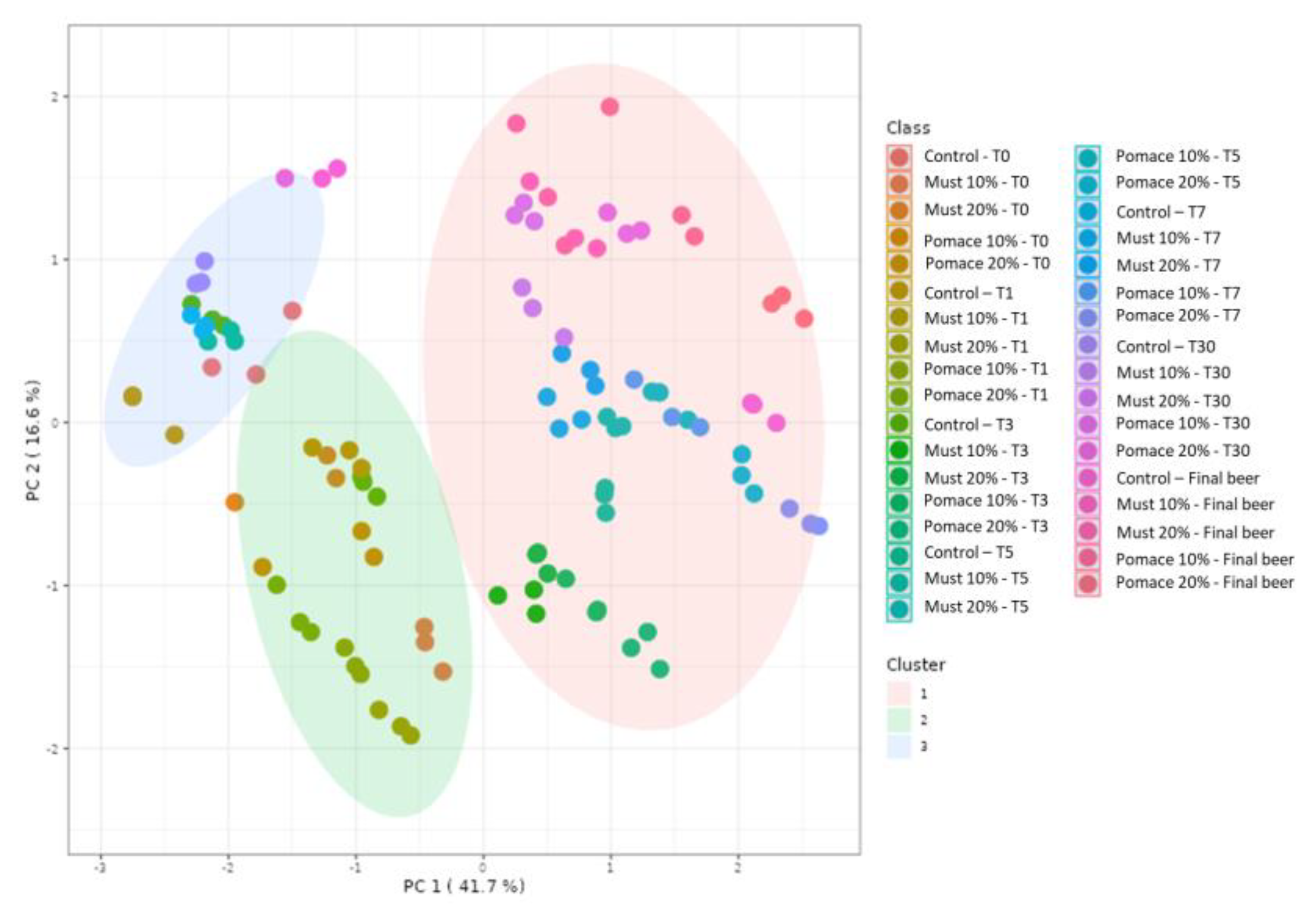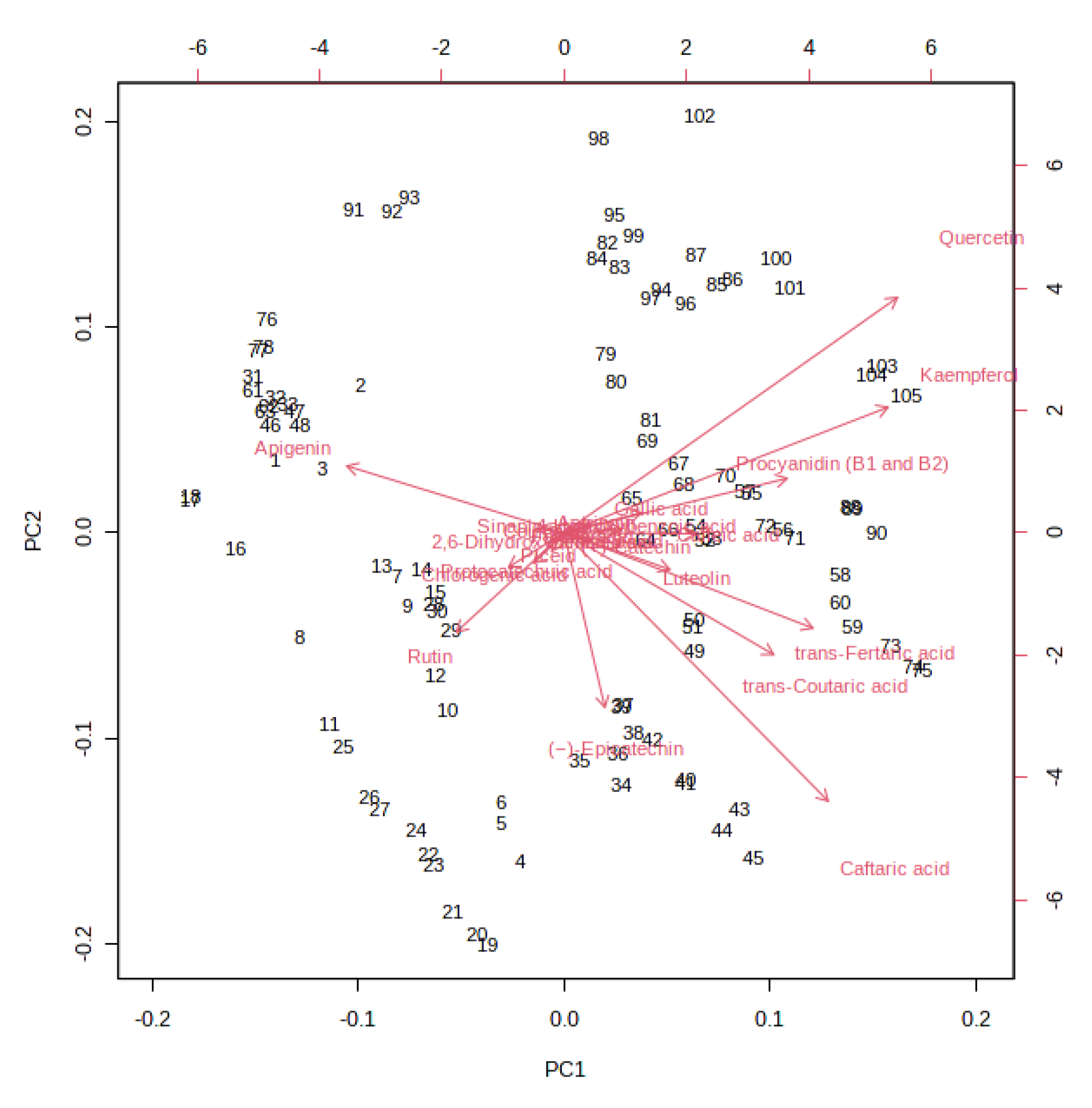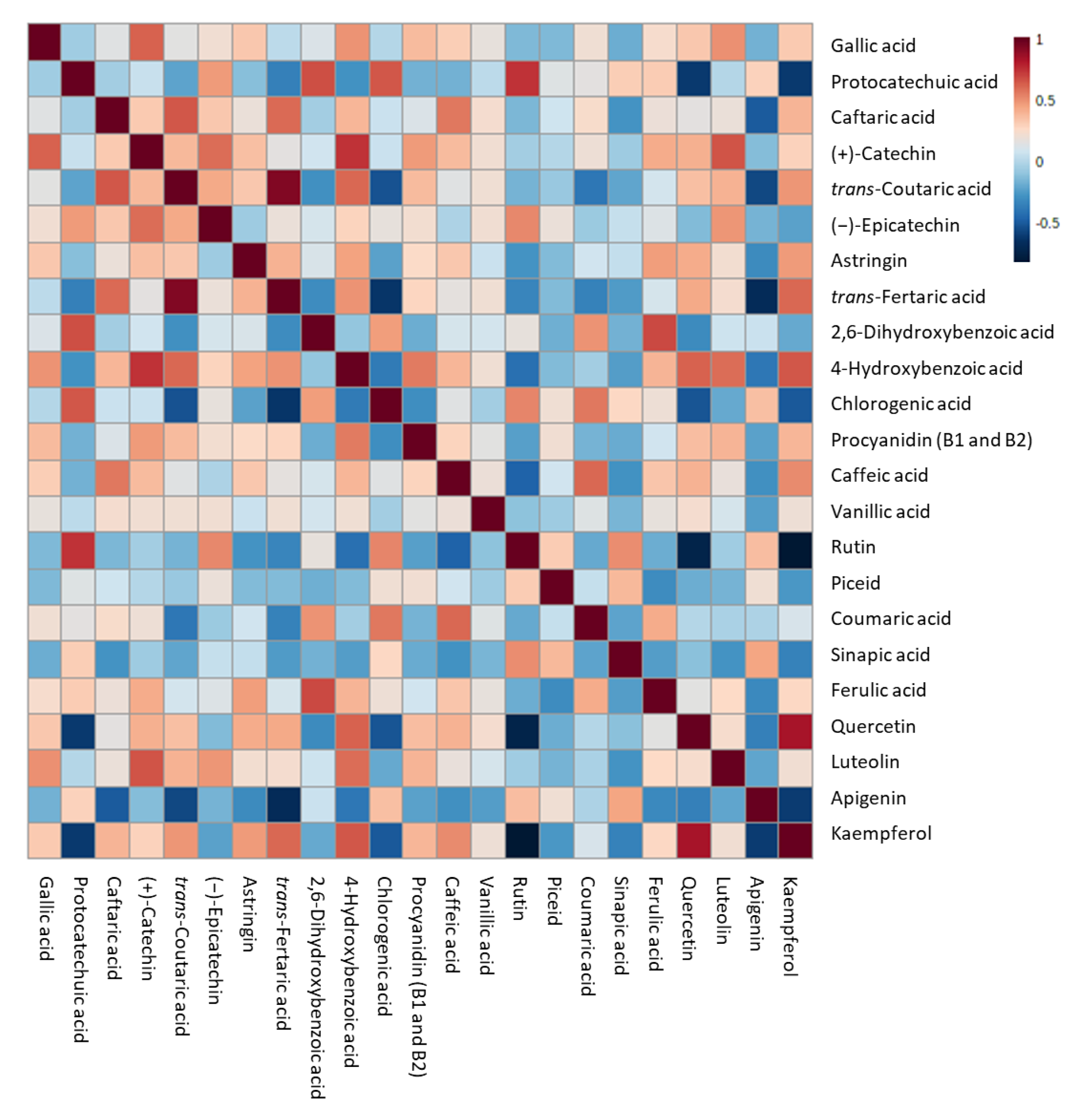Italian Grape Ale Beers Obtained with Malvasia di Candia Aromatica Grape Variety: Evolution of Phenolic Compounds during Fermentation
Abstract
1. Introduction
2. Materials and Methods
2.1. Reagent and Standards
2.2. Experimental Design
2.3. (Poly)Phenol Extraction from Beers
2.4. (Poly)Phenol Analysis with HPLC-MS/MS
2.5. Statistical Analysis
3. Results
4. Discussion
Supplementary Materials
Author Contributions
Funding
Institutional Review Board Statement
Informed Consent Statement
Data Availability Statement
Conflicts of Interest
References
- Alcoholic Drinks—Worldwide | Statista Market Forecast. Available online: https://www.statista.com/outlook/cmo/alcoholic-drinks/worldwide (accessed on 6 March 2023).
- Beer Judge Certification Program—Promoting Beer Literacy, Recognizing Beer Tasting and Evaluation Skills. Available online: https://www.bjcp.org/ (accessed on 28 December 2022).
- de Francesco, G.; Marconi, O.; Sileoni, V.; Perretti, G. Barley Malt Wort and Grape Must Blending to Produce a New Kind of Fermented Beverage: A Physicochemical Composition and Sensory Survey of Commercial Products. J. Food Compos. Anal. 2021, 103, 104112. [Google Scholar] [CrossRef]
- Garavaglia, C. The Emergence of Italian Craft Breweries and the Development of Their Local Identity. Geogr. Beer: Cult. Econ. 2020, 135–147. [Google Scholar] [CrossRef]
- Castro Marin, A.; Baris, F.; Romanini, E.; Lambri, M.; Montevecchi, G.; Chinnici, F. Physico-Chemical and Sensory Characterization of a Fruit Beer Obtained with the Addition of Cv. Lambrusco Grapes Must. Beverages 2021, 7, 34. [Google Scholar] [CrossRef]
- Nardini, M.; Garaguso, I. Characterization of Bioactive Compounds and Antioxidant Activity of Fruit Beers. Food Chem. 2020, 305, 125437. [Google Scholar] [CrossRef]
- Fumi, M.D.; Galli, R.; Lambri, M.; Donadini, G.; de Faveri, D.M. Effect of Full-Scale Brewing Process on Polyphenols in Italian All-Malt and Maize Adjunct Lager Beers. J. Food Compos. Anal. 2011, 24, 568–573. [Google Scholar] [CrossRef]
- Baigts-Allende, D.K.; Pérez-Alva, A.; Ramírez-Rodrigues, M.A.; Palacios, A.; Ramírez-Rodrigues, M.M. A Comparative Study of Polyphenolic and Amino Acid Profiles of Commercial Fruit Beers. J. Food Compos. Anal. 2021, 100, 103921. [Google Scholar] [CrossRef]
- Negro, C.; Tommasi, L.; Miceli, A. Phenolic Compounds and Antioxidant Activity from Red Grape Marc Extracts. Bioresour. Technol. 2003, 87, 41–44. [Google Scholar] [CrossRef] [PubMed]
- Lachman, J.; Šulc, M.; Faitová, K.; Pivec, V. Major Factors Influencing Antioxidant Contents and Antioxidant Activity in Grapes and Wines. Int. J. Wine Res. 2009, 1, 101–121. [Google Scholar] [CrossRef]
- Gasiński, A.; Kawa-Rygielska, J.; Mikulski, D.; Kłosowski, G.; Głowacki, A. Application of White Grape Pomace in the Brewing Technology and Its Impact on the Concentration of Esters and Alcohols, Physicochemical Parameteres and Antioxidative Properties of the Beer. Food Chem. 2022, 367, 130646. [Google Scholar] [CrossRef]
- Veljovic, M.; Djordjevic, R.; Leskosek-Cukalovic, I.; Lakic, N.; Despotovic, S.; Pecic, S.; Nedovic, V. The Possibility of Producing a Special Type of Beer Made from Wort with the Addition of Grape Must. J. Inst. Brew. 2010, 116, 440–444. [Google Scholar] [CrossRef]
- Quifer-Rada, P.; Vallverdú-Queralt, A.; Martínez-Huélamo, M.; Chiva-Blanch, G.; Jáuregui, O.; Estruch, R.; Lamuela-Raventós, R. A Comprehensive Characterisation of Beer Polyphenols by High Resolution Mass Spectrometry (LC–ESI-LTQ-Orbitrap-MS). Food Chem. 2015, 169, 336–343. [Google Scholar] [CrossRef]
- Neveu, V.; Perez-Jiménez, J.; Vos, F.; Crespy, V.; du Chaffaut, L.; Mennen, L.; Knox, C.; Eisner, R.; Cruz, J.; Wishart, D.; et al. Phenol-Explorer: An Online Comprehensive Database on Polyphenol Contents in Foods. Database 2010, 2010. [Google Scholar] [CrossRef]
- Garrido, J.; Borges, F. Wine and Grape Polyphenols—A Chemical Perspective. Food Res. Int. 2013, 54, 1844–1858. [Google Scholar] [CrossRef]
- Qi, M.; Luo, Z.; Wu, B.; Wang, L.; Yang, M.; Zhang, X.; Lin, X.; Xu, Y.; Li, X.; Li, L. Spatial Distribution and Time-Course of Polyphenol Accumulation in Grape Berry (Vitis Labruscana Cv. ‘Kyoho’). J. Food Compos. Anal. 2022, 106, 104353. [Google Scholar] [CrossRef]
- LI, F.X.; LI, F.H.; YANG, Y.X.; YIN, R.; MING, J. Comparison of Phenolic Profiles and Antioxidant Activities in Skins and Pulps of Eleven Grape Cultivars (Vitis vinifera L.). J. Integr. Agric. 2019, 18, 1148–1158. [Google Scholar] [CrossRef]
- Arranz, S.; Chiva-Blanch, G.; Valderas-Martínez, P.; Medina-Remón, A.; Lamuela-Raventós, R.M.; Estruch, R. Wine, Beer, Alcohol and Polyphenols on Cardiovascular Disease and Cancer. Nutrients 2012, 4, 759. [Google Scholar] [CrossRef]
- Radonjić, S.; Maraš, V.; Raičević, J.; Košmerl, T. Wine or Beer? Comparison, Changes and Improvement of Polyphenolic Compounds during Technological Phases. Molecules 2020, 25, 4960. [Google Scholar] [CrossRef] [PubMed]
- Carvalho, D.O.; Guido, L.F. A Review on the Fate of Phenolic Compounds during Malting and Brewing: Technological Strategies and Beer Styles. Food Chem. 2022, 372, 131093. [Google Scholar] [CrossRef]
- (PDF) The Influence of Raw Materials and Fermentation Conditions on the Polyphenol Content of Grape Beer. Available online: https://www.researchgate.net/publication/279481687_The_influence_of_raw_materials_and_fermentation_conditions_on_the_polyphenol_content_of_grape_beer (accessed on 5 October 2022).
- Thai Huynh, N.; van Camp, J.; Smagghe, G.; Raes, K.; Thanh Ward, T.; Phu District, T.; Chi Minh City, H. Improved Release and Metabolism of Flavonoids by Steered Fermentation Processes: A Review. Int. J. Mol. Sci. 2014, 15, 19369–19388. [Google Scholar] [CrossRef]
- Ambra, R.; Pastore, G.; Lucchetti, S. The Role of Bioactive Phenolic Compounds on the Impact of Beer on Health. Molecules 2021, 26, 486. [Google Scholar] [CrossRef]
- Coghe, S.; Benoot, K.; Delvaux, F.; Vanderhaegen, B.; Delvaux, F.R. Ferulic Acid Release and 4-Vinylguaiacol Formation during Brewing and Fermentation: Indications for Feruloyl Esterase Activity in Saccharomyces Cerevisiae. J. Agric. Food Chem. 2004, 52, 602–608. [Google Scholar] [CrossRef] [PubMed]
- Chrzanowski, G. Saccharomyces Cerevisiae—An Interesting Producer of Bioactive Plant Polyphenolic Metabolites. Int. J. Mol. Sci. 2020, 21, 7343. [Google Scholar] [CrossRef] [PubMed]
- García-Conesa, M.T.; Larrosa, M. Polyphenol-Rich Foods for Human Health and Disease. Nutrients 2020, 12, 400. [Google Scholar] [CrossRef]
- Fraga, C.G.; Croft, K.D.; Kennedy, D.O.; Tomás-Barberán, F.A. The Effects of Polyphenols and Other Bioactives on Human Health. Food Funct. 2019, 10, 514–528. [Google Scholar] [CrossRef] [PubMed]
- Alcoholic Drinks and Cancer Risk—WCRF International. Available online: https://www.wcrf.org/diet-activity-and-cancer/risk-factors/alcoholic-drinks-and-cancer-risk/ (accessed on 28 December 2022).
- Linee Guida per Una Sana Alimentazione 2018—Linee Guida per Una Sana Alimentazione 2018—Food and Nutrition—CREA. Available online: https://www.crea.gov.it/en/web/alimenti-e-nutrizione/-/linee-guida-per-una-sana-alimentazione-2018 (accessed on 28 December 2022).





| Compound | Ionization Mode | Precursor Ion (m/z) | Product Ions (m/z) | Collision Energy (V) | Linear Range (ppm) | LOQ (ppm) | LOD (ppm) |
|---|---|---|---|---|---|---|---|
| Apigenin | Positive | 271.1 | 91.1/118.9/152.9 | +39/+30/+30 | 0.003–5.0 | 0.003 | 0.001 |
| Astringin | Negative | 451.3 | 200.9/243.1/405.1 | –43/–25/–9 | 0.1–5.0 | 0.010 | 0.003 |
| Caffeic acid | Positive | 181.1 | 89.1/116.9/163.1 | +29/+21/+9 | 0.1–5.0 | 0.100 | 0.030 |
| Caftaric acid | Negative | 311.1 | 135.1/149.1/178/9 | –26/–8/–12 | 0.1–5.0 | 0.050 | 0.020 |
| (+)-Catechin | Negative | 335.2 | 203.0/245.1/289.0 | –23/–18/–7 | 0.5–15.0 | 0.100 | 0.030 |
| Chlorogenic acid | Positive | 355.2 | 117.1/144.9/163.0 | +24/+15/+9 | 0.1–5.0 | 0.050 | 0.015 |
| Coumaric acid | Positive | 165.1 | 91.1/119.0/147.0 | +24/+18/+10 | 0.003–5.0 | 0.003 | 0.001 |
| trans-Coutaric acid | Negative | 295.2 | 113.1/119.1/163.0 | –10/–23/–11 | 0.1–5.0 | 0.100 | 0.030 |
| 2,6-Dihydroxybenzoic acid | Negative | 153.1 | 65.1/109.0/135.0 | –19/–14/–13 | 0.04–15.0 | 0.010 | 0.003 |
| (−)-Epicatechin | Negative | 335.2 | 203.0/245.1/289.1 | –23/–18/–7 | 0.04–15.0 | 0.010 | 0.003 |
| (−)-Epigallocatechin | Negative | 305.1 | 125.1/165.1/179.0 | –19/–15/–13 | 1.0–5.0 | 1.000 | 0.300 |
| trans-Fertaric acid | Negative | 325.2 | 113.0/134.0/193.1 | –10/–27/–12 | 0.1–5.0 | 0.050 | 0.015 |
| Ferulic acid | Positive | 195.1 | 89.1/144.9/177.1 | +31/+16/+9 | 0.5–15.0 | 0.100 | 0.030 |
| Gallic acid | Negative | 169.1 | 79.04/71.1/124.9 | –22/–17/–13 | 0.1–5.0 | 0.100 | 0.030 |
| (+)-Gallocatechin | Negative | 305.2 | 125.1/177.1/219.2 | –20/–19/–15 | 1.0–5.0 | 1.000 | 0.300 |
| 4-Hydroxybenzoic acid | Negative | 183.1 | 93.0/137.1/139.1 | –19/–5/–5 | 0.1–5.0 | 0.100 | 0.030 |
| Kaempferol | Positive | 287.3 | 120.9/153.0/212.9 | +30/+31/+28 | 0.1–5.0 | 0.050 | 0.020 |
| Luteolin | Positive | 287.3 | 135.1/153.0/241.1 | +32/+32/+32 | 0.01–5.0 | 0.010 | 0.003 |
| Piceid | Positive | 391.2 | 106.9/135.0/229.1 | +38/+26/+9 | 0.1–5.0 | 0.100 | 0.030 |
| Procyanidin (B1 and B2) | Positive | 579.3 | 291.1/409.1/427.2 | +14/+18/+14 | 0.1–5.0 | 0.050 | 0.015 |
| Protocatechuic acid | Negative | 153.0 | 81.0/90.9/108.8 | –23/–22/–13 | 0.05–15.0 | 0.050 | 0.015 |
| Quercetin | Positive | 303.1 | 136.9/152.9/ | +30/+31/+28 | 0.01–5.0 | 0.010 | 0.003 |
| Rutin | Positive | 611.3 | 303.1/465.3 | +20/+10 | 0.05–15.0 | 0.050 | 0.015 |
| Sinapic acid | Positive | 225.2 | 118.9/175.1/206.9 | +20/+14/+8 | 0.1–5.0 | 0.100 | 0.030 |
| Vanillic acid | Positive | 169.1 | 64.9/93.1/125.0 | +23/+14/+10 | 0.1–5.0 | 0.100 | 0.030 |
| Sample | Quercetin (ppm) | Caftaric Acid (ppm) | Trans-Fertaric Acid (ppm) | Kaempferol (ppm) | |||||||||
|---|---|---|---|---|---|---|---|---|---|---|---|---|---|
| Control | T0 | 0.05 | ± | 0.01 b | <LOD | <LOD | <LOD | ||||||
| T1 | <LOD | <LOD | <LOD | <LOD | |||||||||
| T3 | <LOD | <LOD | <LOD | <LOD | |||||||||
| T5 | <LOD | <LOD | <LOD | <LOD | |||||||||
| T7 | <LOD | <LOD | <LOD | <LOD | |||||||||
| T30 | <LOD | <LOD | <LOD | <LOD | |||||||||
| Final beer | 0.07 | ± | 0.01 c | <LOD | <LOD | 0.1 | ± | 0.04 b | |||||
| Must 10% | T0 | <LOD | 2.07 | ± | 0.95 bc | 0.4 | ± | 0.02 a | <LOD | ||||
| T1 | <LOD | 3.09 | ± | 0.59 c | 0.49 | ± | 0.02 ab | <LOD | |||||
| T3 | <LOD | 3.07 | ± | 1.02 c | 0.65 | ± | 0.05 bc | 0.11 | ± | 0.04 ab | |||
| T5 | 0.09 | ± | 0.01 ab | 2.82 | ± | 0.47 c | 0.72 | ± | 0.02 c | 0.3 | ± | 0.01 b | |
| T7 | 0.15 | ± | 0.02 b | 0.73 | ± | 0.21 ab | 0.52 | ± | 0.07 abc | 0.36 | ± | 0.09 b | |
| T30 | 0.16 | ± | 0.02 b | 0.25 | ± | 0.15 a | 0.6 | ± | 0.07 abc | 0.31 | ± | 0.06 b | |
| Final beer | 0.47 | ± | 0.09 c | 0.32 | ± | 0.08 a | 0.47 | ± | 0.18 ab | 0.82 | ± | 0.23 c | |
| Must 20% | T0 | <LOD | <LOD | 0.82 | ± | 0.06 a | <LOD | ||||||
| T1 | <LOD | 1.04 | ± | 0.29 c | 0.97 | ± | 0.01 ab | <LOD | |||||
| T3 | <LOD | 1.26 | ± | 0.26 c | 1.25 | ± | 0.02 bc | 0.18 | ± | 0.01 b | |||
| T5 | 0.17 | ± | 0.01 b | 0.61 | ± | 0.07 b | 1.43 | ± | 0.1 c | 0.32 | ± | 0.03 bc | |
| T7 | 0.18 | ± | 0.02 b | 0.19 | ± | 0.07 ab | 1.17 | ± | 0.08 bc | 0.41 | ± | 0.06 c | |
| T30 | 0.24 | ± | 0.04 b | <LOD | 1.31 | ± | 0.21 c | 0.32 | ± | 0.10 bc | |||
| Final beer | 0.52 | ± | 0.05 c | 0.15 | ± | 0.03 a | 0.86 | ± | 0.15 a | 0.4 | ± | 0.08 c | |
| Pomace 10% | T0 | <LOD | 0.34 | ± | 0.13 a | 0.13 | ± | 0.004 a | <LOD | ||||
| T1 | <LOD | 0.3 | ± | 0.12 a | 0.4 | ± | 0.06 ab | <LOD | |||||
| T3 | <LOD | 1.37 | ± | 0.22 b | 0.77 | ± | 0.16 c | 0.22 | ± | 0.03 b | |||
| T5 | 0.38 | ± | 0.06 b | 0.34 | ± | 0.11 a | 0.88 | ± | 0.09 c | 0.32 | ± | 0.03 bc | |
| T7 | 0.43 | ± | 0.08 b | 0.38 | ± | 0.15 a | 0.6 | ± | 0.15 bc | 0.29 | ± | 0.06 bc | |
| T30 | 0.58 | ± | 0.09 b | <LOD | 0.76 | ± | 0.14 c | 0.4 | ± | 0.06 c | |||
| Final beer | 2.41 | ± | 0.32 c | 0.36 | ± | 0.13 a | 0.58 | ± | 0.08 bc | 1.01 | ± | 0.13 d | |
| Pomace 20% | T0 | <LOD | <LOD | 0.4 | ± | 0.08 a | <LOD | ||||||
| T1 | <LOD | <LOD | 0.67 | ± | 0.12 ab | <LOD | |||||||
| T3 | <LOD | 2.45 | ± | 0.28 c | 1.3 | ± | 0.26 cd | 0.28 | ± | 0.05 ab | |||
| T5 | 0.52 | ± | 0.04 b | 1.21 | ± | 0.32 b | 1.37 | ± | 0.04 d | 0.37 | ± | 0.07 b | |
| T7 | 0.79 | ± | 0.10 b | 3.03 | ± | 0.8 c | 1.19 | ± | 0.14 cd | 0.43 | ± | 0.06 b | |
| T30 | 0.81 | ± | 0.05 b | 1.05 | ± | 0.38 ab | 1.19 | ± | 0.05 cd | 0.4 | ± | 0.09 b | |
| Final beer | 2.84 | ± | 0.31 c | 1.09 | ± | 0.42 ab | 1.01 | ± | 0.03 bc | 1.06 | ± | 0.31 c | |
Disclaimer/Publisher’s Note: The statements, opinions and data contained in all publications are solely those of the individual author(s) and contributor(s) and not of MDPI and/or the editor(s). MDPI and/or the editor(s) disclaim responsibility for any injury to people or property resulting from any ideas, methods, instructions or products referred to in the content. |
© 2023 by the authors. Licensee MDPI, Basel, Switzerland. This article is an open access article distributed under the terms and conditions of the Creative Commons Attribution (CC BY) license (https://creativecommons.org/licenses/by/4.0/).
Share and Cite
Leni, G.; Romanini, E.; Bertuzzi, T.; Abate, A.; Bresciani, L.; Lambri, M.; Dall’Asta, M.; Gabrielli, M. Italian Grape Ale Beers Obtained with Malvasia di Candia Aromatica Grape Variety: Evolution of Phenolic Compounds during Fermentation. Foods 2023, 12, 1196. https://doi.org/10.3390/foods12061196
Leni G, Romanini E, Bertuzzi T, Abate A, Bresciani L, Lambri M, Dall’Asta M, Gabrielli M. Italian Grape Ale Beers Obtained with Malvasia di Candia Aromatica Grape Variety: Evolution of Phenolic Compounds during Fermentation. Foods. 2023; 12(6):1196. https://doi.org/10.3390/foods12061196
Chicago/Turabian StyleLeni, Giulia, Elia Romanini, Terenzio Bertuzzi, Alessio Abate, Letizia Bresciani, Milena Lambri, Margherita Dall’Asta, and Mario Gabrielli. 2023. "Italian Grape Ale Beers Obtained with Malvasia di Candia Aromatica Grape Variety: Evolution of Phenolic Compounds during Fermentation" Foods 12, no. 6: 1196. https://doi.org/10.3390/foods12061196
APA StyleLeni, G., Romanini, E., Bertuzzi, T., Abate, A., Bresciani, L., Lambri, M., Dall’Asta, M., & Gabrielli, M. (2023). Italian Grape Ale Beers Obtained with Malvasia di Candia Aromatica Grape Variety: Evolution of Phenolic Compounds during Fermentation. Foods, 12(6), 1196. https://doi.org/10.3390/foods12061196










